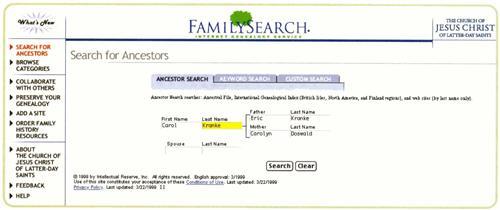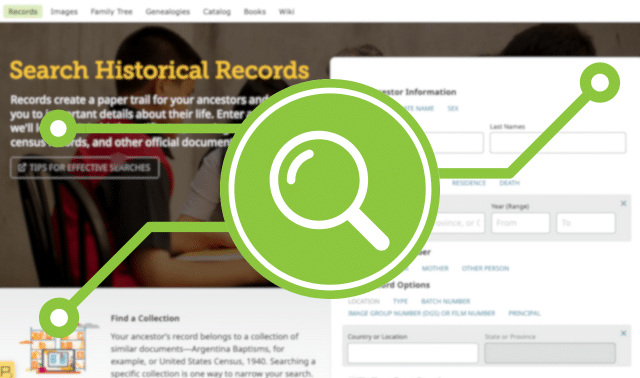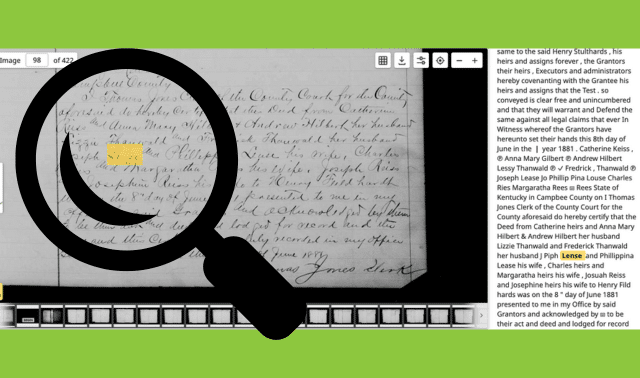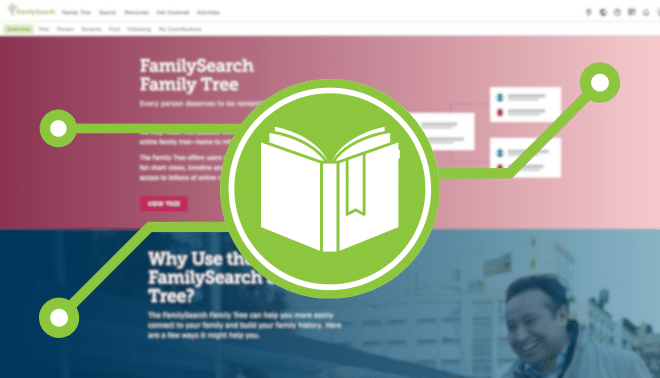
You probably already know just how wildly popular the Church of Jesus Christ of Latter-day Saints’ (LDS) new FamilySearch Web site <www.familysearch.org> is. After months of rumors and eight weeks of beta testing, the site’s formal launch was announced May 24, recording 60 million hits the first day and 100 million the second. The volume meant it took some enthusiasts days or even weeks to gain access to FamilySearch.
“We didn’t anticipate quite that much traffic, and there were some delays,” says LDS spokesman Michael Purdy, though he says the site never actually crashed. Traffic has now leveled off to 35 million to 45 million hits per day, Purdy says.
Once you do get access, the bad news is that FamilySearch isn’t perfect and isn’t arranged in the fashion that’s become a de facto standard on the Web. It’s especially frustrating not to be able to review past exchanges between people who are searching surnames in which you’re interested. Still, the church is at work on improvements and the addition of more databases.
The good news is that using the massive LDS resources online is a lot easier than making the trek to the church’s Family History Library in Salt Lake City (something 2,500 people do daily), and even easier than visiting its 3,200 Family History Centers in 64 countries. And at this point, there’s absolutely no charge for accessing the files. As always, the church encourages those who use its resources to share their data. It’s a religious obligation for the LDS faithful to identify ancestors so they can be united with them in the afterworld.
If you haven’t explored the site yet, here’s what you’re missing:
The most prominent feature on the opening page lets you search for ancestors, which is simple and straightforward. It’s a bit of a disappointment in action, however; some bugs remain and the geographic area covered is somewhat limited. The feature includes the LDS Ancestral File, 35 million-plus names; the International Genealogical Index (IGI) for the British Isles, North America and Finland regions, a whopping 360 million-plus names (additional regions are coming); and Web sites, which of course can be searched from many other genealogical pages.
You must enter the first and last name for the person being searched; initially, if you wanted to narrow the search by the person’s spouse and parents, you needed to enter both first and last names for those individuals. The church has changed that feature to accept first names only. (In general, the church has been quick to fix problems on the site. For updates, there’s a What’s New button on the home page. A feedback form lets you report glitches.)
After you’ve entered the name, you’ll be linked to any matches among the three sources (Ancestral File, IGI and Web). If you get too many results, you can refine your search. The Refine Search feature has been up and down; too often, you’re returned to the original page, meaning you can refine only by adding a spouse or parent name, information you may not have.
At this stage, the Web links aren’t always accurate. In fact, one link that showed on a wide variety of names searched saw fit to include information on its home page basically saying, “I don’t know why the LDS site brought you here. Please don’t complain to me.”
Soundex searching for similar-sounding names isn’t possible, but there is limited matching leeway. For example, a search for “Henifin” also brought back “Henefin” matches, but a search that included the first name “Malinda” didn’t retrieve “Melinda” matches.
The good news is that using the massive LDS resources online is a lot easier than making the trek to the church’s Family History Library in Salt Lake City.
When you do find a true match in the ancestral file, it can be worth all the manipulation and refining trials. It’s possible to get the name and address of the person who provided the information, and it can be a lot of fun to work a line and exchange data with a long-lost or previously unknown cousin.
Besides the ancestor search option, it’s possible to search Web sites and the church’s SourceGuide, more than 150 LDS publications, by keyword. A custom search option lets you select the database you want.
Beyond database searches, the site’s Collaborate With Others feature could be the category killer for surname search sites, listservs and newsgroups. When we last checked, there were more than 17,000 lists of specific individual, surname, place and category interest, divided alphabetically by the first two letters. There are problems: Because individuals create these groups instantly without the guidance of a moderator, there can be several for surnames that likely are of common interest (Hanifin and Henefin, for example). Further, the sheer size of the database means it can take a long time to get to lists for which you want to register.
There’s no charge to sign up to collaborate, but you can post messages only to lists for which you’ve registered. Once you’ve registered for the surnames, there’s a View My Lists option that’s handy when you want to post. But there’s currently no way to review past messages, a big problem that unless it’s fixed will result in people covering the same ground over and over again.
The FamilySearch site also offers access to: SourceGuide, more than 150 church publications on genealogy; the ability to buy church-produced family history publications, software and CDs; locations for Family History Centers; a way to recommend a Web site to be included in the FamilySearch service; and the means by which to submit your own ancestral information. And there’s more ahead: When we went to press, the church was beta-testing online surname searches of its Family History Library Catalog of hundreds of thousands of books and maps. While the resources aren’t yet available via the Web, the information can help make the most of your time when you get to a Family History Center.
So be patient and keep trying FamilySearch. It’s worth the effort to rise early or stay up late to get in.
From the January 2000 issue of Family Tree Magazine




